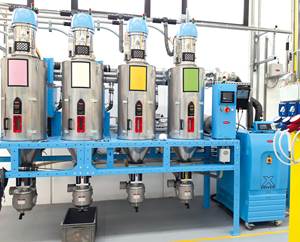Overcoming Drying Hopper Ambient Air Leaks
Consider using a compressed-air-operated discharge valve. This provides a positive seal when it closes and ensures that no wet ambient air seeps into the drying hopper.
Vacuum loaders used to load materials into a drying hopper typically employ what is called a gravity-discharge valve. The discharge valve employs a flapper that hangs freely beneath the vacuum loader. When the material level within the drying hopper falls below the vacuum loader’s discharge valve flapper, it allows a path for ambient air to enter the top of the drying hopper due to the suction of the return air circuit (Figure 1).
FIG 1 — With a gravity discharge valve, when the material level within the drying hopper falls below the vacuum loader’s discharge valve flapper, it enables a path for ambient air to enter the top of the drying hopper due to the suction of the return air circuit.
Also, at this point the level switch built into the discharge valve closes and calls for more material to be loaded into the drying hopper. Next, a vacuum is applied to the loader body which pulls the gravity discharge valve into the closed position. (Figure 2) The vacuum loader will pull material from the source of supply on a timed cycle, which is manually adjusted for the optimum amount of time determined by the machine operator.
FIG 2 — When the level switch built into discharge valve closes, a vacuum is applied to the loader body which pulls the gravity discharge valve into the closed position.
When the vacuum loader’s timer completes its cycle and the vacuum is shut off, gravity takes over to allow the material within the loader body to force the flapper discharge valve to open and discharge the material into the drying hopper. (Figure 3).
FIG 3 — When the vacuum is shut off, the force of gravity enables material within the loader body to force the flapper discharge valve to open and discharge the material into the drying hopper.
During the time shown in Figures 1 and 3, the suction of the dryer’s return air circuit will be drawing some ambient air along with ambient moisture into the “closed loop circuit” via the dryer’s return air circuit.
In many cases, this small amount of ambient air entering the “closed loop air circuit” will not cause a problem due to several reasons such as:
- Dehumidifying polymer dryers are sized to perform well during the hot, humid summer months of June through September, when ambient dew point levels often reach as high as 60° to 80° F, and coast along with little effort during the relatively cool dry months from October through May.
- Some polymers such as ABS, acrylics and some others are mildly hygroscopic and easily dried.
- Some polymers such as DuPont’s Zytel (nylon) are more forgiving of moisture content and can be successfully molded with a moisture content of up to 0.20% or 2,000 ppm, according to DuPont’s Zytel molding guide.
However, some polymers are much more sensitive to moisture during processing. Polymers such as PET, PBT and most other polyesters (along with polycarbonate and some polyurethanes) can cause endless problems if not dried to extremely low residual moisture levels during the hot, humid summer months.
So how do we contend with a low volume of wet ambient air leaking into our drying system when processing extremely sensitive polymers during the hot, humid summer months?
The answer may be a compressed-air-operated discharge valve that provides a positive seal when it closes and ensures that no wet ambient air seeps into the drying hopper (Figure 4, right).
Another option is a custom-made transition hopper between the drying hopper and the vacuum loader, which will be filled with material and thereby block the path of ambient air entering the drying hopper through the vacuum loader (Figure 4, left).
FIG 4 — A compressed air-operated discharge valve provides a positive seal when it closes and ensures that no wet ambient air seeps into the drying hopper (top).
ABOUT THE AUTHOR: Pete Stoughton has more than 40 years’ experience with dehumidifying dryers and PET crystallizing systems. He has held various technical positions with the Conair Group, including technical services manager, product manager and ┤¾¤¾┤½├¢ unit manager. He now has his own consulting firm, Polymer Drying Services. Contact: 814-516-3838; pstoughton@comcast.net; .
Related Content
Finding Efficiencies in How Components Work Together
Auxiliary systems are vital to the proper functioning of a plastic processing line, and they can be a source of major cost and efficiency improvements.
Read MoreAI Manages Resin Drying Airflows and Throughputs for Energy Savings
NPE2024: Optional feature automates the process of maintaining process-ready resins at perfect temperatures and varied throughputs, while preventing overdrying and realizing significant energy savings.
Read MorePTXPO Recap: Smarter Resin Drying & Conveying Automation
Check out what you missed on the PTXPO show floor. In this video, Editorial Director Jim Callari breaks down how AI is changing the game in plastics manufacturing.
Read MoreProgram Provides Equipment Maintenance, Overhauls and Upgrades
NPE2024: Program aims to ensure equipment remains at peak performance levels throughout its life cycle.
Read MoreRead Next
See Recyclers Close the Loop on Trade Show Production Scrap at NPE2024
A collaboration between show organizer PLASTICS, recycler CPR and size reduction experts WEIMA and Conair recovered and recycled all production scrap at NPE2024.
Read MoreFor PLASTICS' CEO Seaholm, NPE to Shine Light on Sustainability Successes
With advocacy, communication and sustainability as three main pillars, Seaholm leads a trade association to NPE that ‘is more active today than we have ever been.’
Read More











